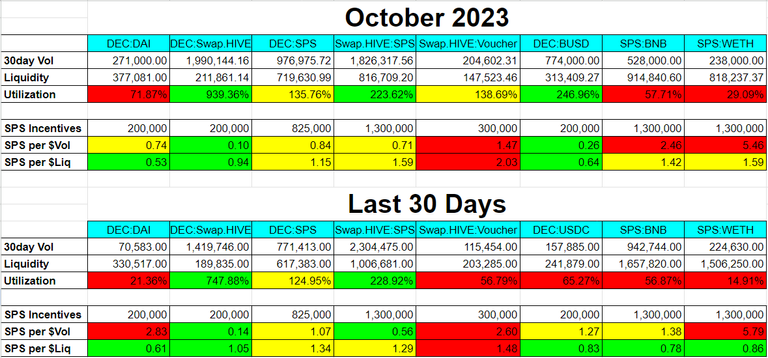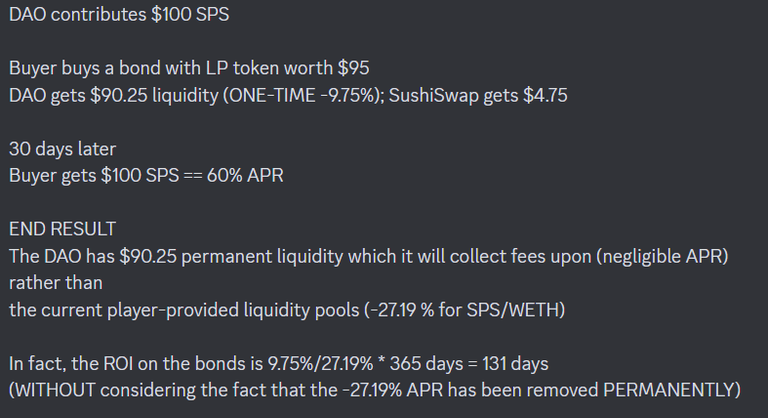A Sustainable Approach to SPS DAO Liquidity Pools

Since we originally broached the subject of reworking our LPs and adjusting the inflation being spent on them, I have spent quite a lot of hours talking to LP providers, project managers for different communities that run their own LPs and knowledgeable devs that have launched successful projects as well as one of the Splinterlands devs that has extensive knowledge when it comes to creating, launching, and building valuable LPs. In short, I've done a lot more research to ensure that I'm adequately knowledgeable on current defi trends, learned what we can do better and analyzed if we have the ability and resources to execute a sound plan going forward.
The good news is that I have learned a lot and discovered ways in which the defi landscape is evolving and growing, we do have opportunities for improvement and while I don't expect unanimous support, even most of our current liquidity providers have agreed with me that we need to make some changes. I don't want this post to be overly complicated and loaded with jargon so I'm going to do my best to really break down the concepts that I'll be discussing as far as I can. While this post may lack some depth for the more crypto savvy, it should be easy to understand for all. If you still have questions after reading, feel free to drop them in the comments and I'll provide answers.
Where We're At Right Now
Currently we're minting 5,625,000 SPS per month to rent liquidity from liquidity providers in 8 pools. Providers lock up their tokens into a liquidity pool for other users to trade against and in turn they earn trading fees from the pool as well additional incentives from the SPS inflation that we are minting to reward them. This process is known as liquidity mining.
Currently the value of that SPS inflation is over $150,000 per month. These incentives can be great for initially attracting liquidity and growing a pool, but the problem is that once we stop paying the incentives the liquidity providers will generally remove their funds and place them somewhere more lucrative. In short, the DAO can spend the money until it has no more and then the DAO is left with nothing. In short, we need a better more sustainable solution that can benefit both the SPS DAO and our liquidity providers.
Below you can see a breakdown of volume and liquidity as well as performance indicators for each of the pools we're supporting with SPS inflation. I included the chart from a few months back when I initially did this as well as the previous 30 days for comparison:

Green = Best Value, Yellow = Some Value, Red = Bad Value
What Options Do We Have?
At present we have a few options: we can continue to print this inflation for another 3 years, which is roughly when the whitepaper distribution ends, and then come up with some mechanism for funding further incentives, we can cut off the inflation and likely collapse our pools without utilizing DAO resources to maintain liquidity, or we can start considering ways to use the inflation that are more sustainable and beneficial to the DAO.
As far as sustainable options go, having the DAO take over ownership of some of the less utilized pools could be an easy win. We'd be able to cut inflation spending while also generating a little revenue on idle assets. Essentially we could cut spending while creating a valuable revenue stream. This doesn't do anything to benefit the liquidity providers, but it is an option and I think at least a partial solution.
I have spent a significant amount of time diving into the concept of defi bonds and we already have a proposal approved to try one. We're still doing some groundwork to get that launched, but the concept itself is solid and if we succeed I'd like to see us doing more things like this. Part of the groundwork being done is ensuring that we're able to expand our token to more chains if the DAO choose to do so.
My Analysis and Recommendations for Sustainable LPs
One of the biggest problems our token has is that there's not much volume. Of course we can point out the supply and demand issues, but there's more to it than that. Over printing the token isn't doing us any favor and added demand will fix a lot of our problems. That doesn't mean we can't make smart moves to make our token more appealing.
We're currently operating on the assumption that going deep is better than going wide when it comes to liquidity. This isn't always true and in our case may actually be inhibiting our growth. Sure, having deeper liquidity pools allows for whales to splash funds around without a huge price impact, but it's not great for traders and it isn't great for liquidity providers either unless there's high volume.
The reason we're having to pay such high incentives to liquidity providers is because the pools we're running mostly aren't profitable. They aren't generating enough trading fees to justify the amount of liquidity that is currently parked in them and our DAO is left printing $150,000 worth of our token a month (at today's $0.027 price) while sitting on over $10 million in assets that we could deploy to those unprofitable pools ourselves. A miniscule amount of revenue is a net positive as opposed to just printing money and devaluing our token for underutilized pools.
I know there are many people that want to just shut off LP rewards, but I also think we can find a better solution that is more valuable for the DAO. It's clear that with a tool like defi bonds we can actually create a win-win situation for both our DAO and our liquidity providers. Let's use the sushiswap proposal as a basis for understanding the math on this.
We'll use $100 for simplicity sake and assume we're working with a partner like SushiSwap (for marketing benefits and technical expertise) which would put our fees at 9.75% all included. This provides a 60% APR for our bond buyers (liquidity providers) while creating a situation where the DAO breaks even on expenses in under 19 weeks.

The reason this is so much more sustainable is that instead of an ongoing cost to the DAO (printing inflation to rent liquidity), we're able to provide a higher burst APR to our liquidity providers by selling bonds and the DAO then owns the liquidity. The DAO owning the liquidity not only eliminates an ongoing expenditure, but creates assets that the DAO owns, controls, and can earn revenue with going forward.
To really boost the SPS trading volume, our best bet is to increase volatility. Volatility creates arbitrage opportunities which in turn attracts traders. In order to increase volatility, we need to create many smaller liquidity pools, perhaps $10,000 each, with unique trading pairs spread across many chains.
The reason this creates volatility is we'll have exposure to more tokens that all fluctuate in price. The smaller pools mean it's easier to have price impact when token prices change and lower liquidity in the pools allows for easier turnover which makes the trading fees offer a better APR than on the massive pools which need much higher volume to generate high trading fees, which is why we have to pay for the liquidity in them.
Let's say for example that we have an SPS - Arbitrum pair and the price of Arbitrum goes up or down while SPS stays the same, then there is an arbitrage opportunity on our SPS - Arbitrum pair and a trader will take advantage of that giving us volume. Extrapolate this out over several pools on several chains and our volume increase significantly. Pools that are getting high utilization will also attract liquidity providers because the fees generated will offer a high enough APR to make sense to do so.
My suggestion is that we aim to cut 50% of our current liquidity pool incentives and reroute the other 50% to the SPS DAO for use with defi bonds. Whether we work with SushiSwap or determine our own method for selling bonds, we can decide once we see how the SushiSwap partnership goes. They've had to work out some kinks and we've had to set up some things on our end, but I'm hopeful that we'll be good to go there soon.
Assuming we want to do this, I think we should target the cuts on pools that are underperforming or capable of generating decent trading fees and standing on their own. My suggested cuts are to eliminate incentives for DEC:DAI, Swap.Hive:Voucher and SPS:WETH entirely while reducing Swap.Hive:SPS and SPS:BNB to 800,000 per month each. This would free up 2,800,000 SPS per month which could be used for creating new pools.
There may be some concerns that cutting these pools will reduce available liquidity, but keep in mind that the DAO currently sitting on over $10,000,000 worth of assets. This includes Swap.HIVE, Vouchers, and ETH, as well as millions of dollars worth of SPS and DEC, all of which the DAO can deploy to the pools if needed.
Closing Thoughts
Currently I'm making this post for educational purposes and to gather feedback from the community before drafting a proposal. My goal with this is to create a long-term sustainable path forward for the SPS DAO to own its own liquidity and be self sufficient after the whitepaper distribution phase. I feel the best way forward is to look for ways that allow our liquidity providers to help us build long-term value for the SPS DAO as opposed to trying to cut them out entirely and have the DAO just takeover the pools, which many have suggested.
This is my best middle ground solution and I truly believe it has massive potential to help us expand our brand awareness into new chains, set ourselves up for long-term success and to also create valuable opportunities for both liquidity providers and the SPS DAO. Thanks time for your time and consideration!
This sounds like practical common sense to me, and should put the dao on a healthy footing for the future, a future in which we can all live long and prosper.
Sounds good. If the DAO is willing to supply pools more efficiently then us, prefer to see it take that route for as many pools as possible over time.
I'm completely onboard with the idea except for this part:
I am okay with reducing the rewards. Eliminating the rewards should be reserved for later. Either way, we must put the idle resources in the DAO to good use.
Well the thought is that we could cut the most egregiously underperforming pools and the DAO could step in and takeover if there's any demand/need. For example with the SPS:WETH pool we're printing 1.3 million SPS a month (almost $38,000 USD) for a pool doing $238,000 in volume. Whereas we have pools like DEC:SPS doing almost a million dollars in volume with only about $24,000 a month in incentives. Either way we're printing a hell of a lot of a tokens to rent liquidity that we don't really have any need at all to be renting. The DAO is sitting on over $10,000,000 in idle assets we could have in the pools generating revenue as opposed to devaluing our token constantly to rent liquidity we could provide ourselves. It's just not a smart business move in my opinion.
These incentives are definitely wrong and must be at least changed to reflect the demand for each pool. If we utilize the $10 million in idle assets, we may not even have to depend on anyone else to provide liquidity. I am definitely in favor of DAO taking LP positions. I want to see this idea get implemented as fast as possible.